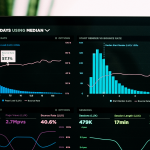Five BI tools to kick off your data function

Organizations across industries are generating more data than ever before, but few have the expertise and resources in place to act and drive competitive business intelligence from it.
While it’s increasingly in vogue for businesses to describe themselves as “data-driven”, 55 percent of data generated is “left in the dark”, according to research by Splunk.
That’s because, while executives claim to recognize the value of using all their data, they often don’t know how to find, prepare, analyze or use it— some don’t even know it exists.
“Data is hard to work with because it’s growing at an alarming rate and is hard to structure and organize,” conceded Splunk’s chief technology officer, Tim Tully.
“In an era where data is connecting devices, systems, and people at unprecedented growth rates, the results show that while data is top of mind, action is often far behind,” read the report.
Lacking in BI expertise
According to a recent poll by MHR Analytics, more than two-thirds (69 percent) of organizations have no dedicated analytics or data science function.
As such, organizations are lacking internal data science expertise, and the means to start applying business intelligence strategies.
“Most businesses are still relying on spreadsheets to store, analyze and report on their data,” said Laura Timms, Product Strategy Manager at MHR Analytics.
“The latest findings from our Data Maturity Quiz show 39 percent of medium to large organizations remain in the early stages of data maturity scale, with their data still managed in Excel.”
“The most effective and most realistic data strategy for any business is to advance on the data journey one stage at a time, gradually meeting more and more business needs through data analytics,” she said.
With that in mind, MHR Analytics compiled a list of the best available tools for businesses to optimize their approach to business intelligence, if they are “just getting started with analytics.”
# 1 | Microsoft Power BI
This transforms complex data into rich, easy to understand visualizations using a drag-and-drop canvas to communicate insights in a digestible way.
Users can share and connect data, access data from supported on-premise and cloud-based sources and create and share mobile-friendly reports on the go. The solution cuts preparation time and provides freedom to use data modeling tools.
Moving forward, users can also unlock advanced analytics features like quick measures, grouping, forecasting and clustering, all with the familiarity of Excel.
# 2 | IBM Cognos Analytics
IBM Cognos Analytics is a self-service platform, which means the average business user with little to no analytics experience can easily see business patterns, create compelling visualizations and answer big business questions.
It can produce ‘data stories’ by combining charts with overlays and voiceovers, can quickly reveal hidden patterns and hard-to-find answers and relationships, and has a natural-language assistant.
YOU MIGHT LIKE

Business leaders aren’t getting ‘hands-on’ with data
# 3 | SAP Analytics Cloud
Hosted in the cloud, this latest tool from SAP provides the ability to experience everything analytics has to offer, without the need for additional infrastructure or having to spend extra money on multiple solutions.
It makes data easy to understand with powerful visualizations. SAP Analytics Cloud enables organizations to plan and forecast in advance and can utilize machine learning to automatically generate insights.
# 4 | IBM Planning Analytics
Effective planning is crucial for any organization, but there are widely varying levels. Relying on spreadsheets can lead to inaccuracies, making the task of using this data in a meaningful way a near-impossible task.
A more sophisticated approach to planning bridges the move from simply reporting what has already happened in an organization, to planning for the future.
IBM Planning Analytics provides a single platform that aligns financial plans with wider objectives, operational tactics, and market events. It automates plans, analyzes, and reports, freeing up time to focus on strategy, transforming the full planning cycle.
# 5 | SAP Business Objects
The collaboration of data across organizations that are still stuck with spreadsheets may be few and far between, with teams using different methods to collect, analyze and store data – often termed “messy data.”
To resolve this sporadic data issue and begin to truly understand why things happen the way they do in an organization, it’s essential to adopt a centralized system.
SAP Business Objects has a single platform for reporting and visualization, supporting anything from a handful of individuals to tens of thousands of users, giving a holistic organizational view and ensuring a single version of the truth.
Manageable steps
“The data maturity journey is about taking manageable steps, rather than huge leaps,” said internationally acclaimed AI expert Bernard Marr in the forthcoming paper Advancing with Analytics: Spreadsheets to AI.
“In this way, every business can advance with analytics– every business can move from spreadsheets to more exciting, cutting-edge analytics techniques. And when you partner with a provider, they take care of all the techy nuts and bolts, leaving you to concentrate on business issues.”









